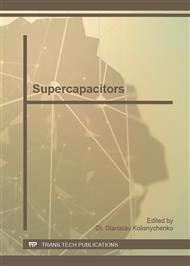[1]
H. Pang, Q. Y. Lu, Y. C. Li and F. Gao, Facile Synthesis of Nickel Oxide Nanotubes and Their Antibacterial, Electrochemical and Magnetic Properties, Chem. Commun. (2009) 7542-7544.
DOI: 10.1039/b914898a
Google Scholar
[2]
H. Pang, Q.Y. Lu, Y.Z. Zhang, Y.C. Li and F. Gao, Selective synthesis of nickel oxide nanowires and length effect on their electrochemical properties, Nanoscale 2 (2010) 920-924.
DOI: 10.1039/c0nr00027b
Google Scholar
[3]
K. H. Chang, C. C. Hu and C. Y. Chou, Textural and Capacitive Characteristics of Hydrothermally Derived RuO2·xH2O Nanocrystallites: Independent Control of Crystal Size and Water Content, Chem. Mater. 19 (2007) 2112-2119.
DOI: 10.1002/chin.200727008
Google Scholar
[4]
C. Z. Yuan, L. Chen, B. Gao, L. H. Su and X. G. Zhang, Synthesis and utilization of RuO2·xH2O nanodots well dispersed on poly(sodium 4-styrene sulfonate) functionalized multi-walled carbon nanotubes for supercapacitors, J. Mater. Chem. 19 (2009), 246-252.
DOI: 10.1039/b811548f
Google Scholar
[5]
C. Z. Yuan, X. G. Zhang, L. H. Su, B. Gao and L. F. Shen, Facile synthesis and self-assembly of hierarchical porous NiO nano/micro spherical superstructures for high performance supercapacitors, J. Mater. Chem. 19 (2009) 5772-5777.
DOI: 10.1039/b902221j
Google Scholar
[6]
L. X. Yang, Y. J. Zhu, H. Tong and W. W. Wang, Submicrocubes and highly oriented assemblies of MnCO3 synthesized by ultrasound agitation method and their thermal transformation to nanoporous Mn2O3, Ultrason. Sonochem. 14 (2007) 259-265.
DOI: 10.1016/j.ultsonch.2006.05.006
Google Scholar
[7]
Z. H. Yang, W. X. Zhang, Q. Wang, X. M. Song and Y. T. Qian, Synthesis of porous and hollow microspheres of nanocrystalline Mn2O3, Chem. Phys. Lett. 418 (2006) 46-49.
DOI: 10.1016/j.cplett.2005.10.076
Google Scholar
[8]
C. C. Yu, L. X. Zhang, J. L. Shi, J. J. Zhao, J. H. Gao and D. S. Yan, A Simple Template-Free Strategy to Synthesize Nanoporous Manganese and Nickel Oxides with Narrow Pore Size Distribution, and Their Electrochemical Properties, Adv. Funct. Mater. 18 (2008) 1544-1548.
DOI: 10.1002/adfm.200701052
Google Scholar
[9]
R. Barnard, C. F. Randell and F. L. Tye, Studies concerning charged nickel hydroxide electrodes I. Measurement of reversible potentials, J. Appl. Electrochem. 10 (1980) 109-125.
DOI: 10.1007/bf00937345
Google Scholar
[10]
J. Cheng, G. P. Cao and Y. S. Yang, Characterization of sol–gel-derived NiOx xerogels as supercapacitors, J. Power Sources 159 (2006) 734-741.
DOI: 10.1016/j.jpowsour.2005.07.095
Google Scholar



